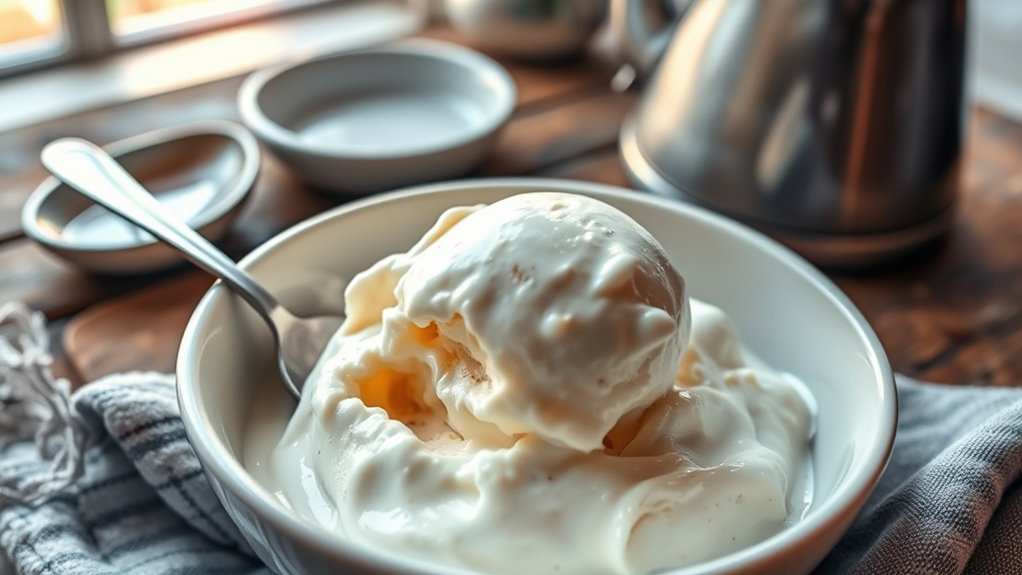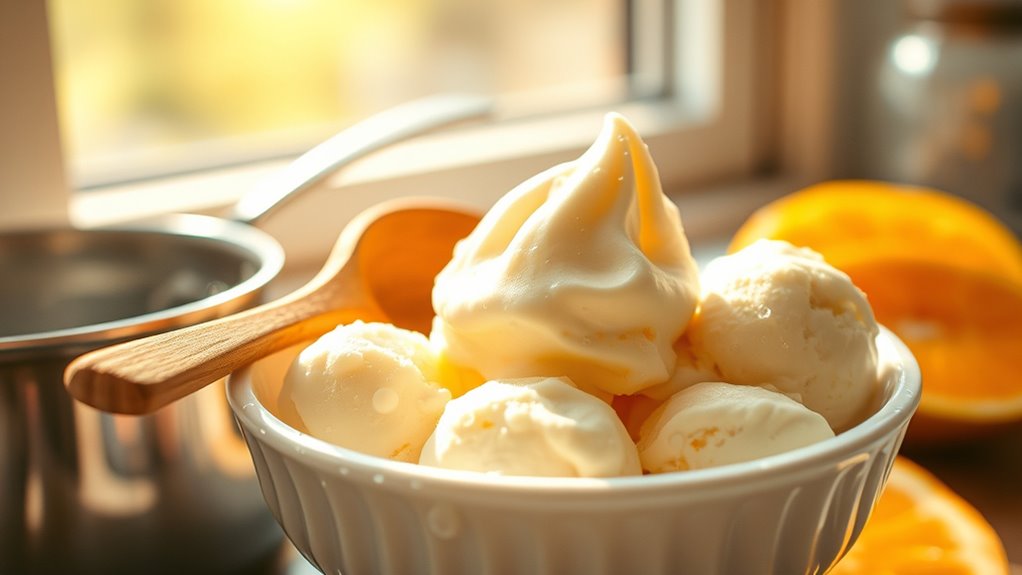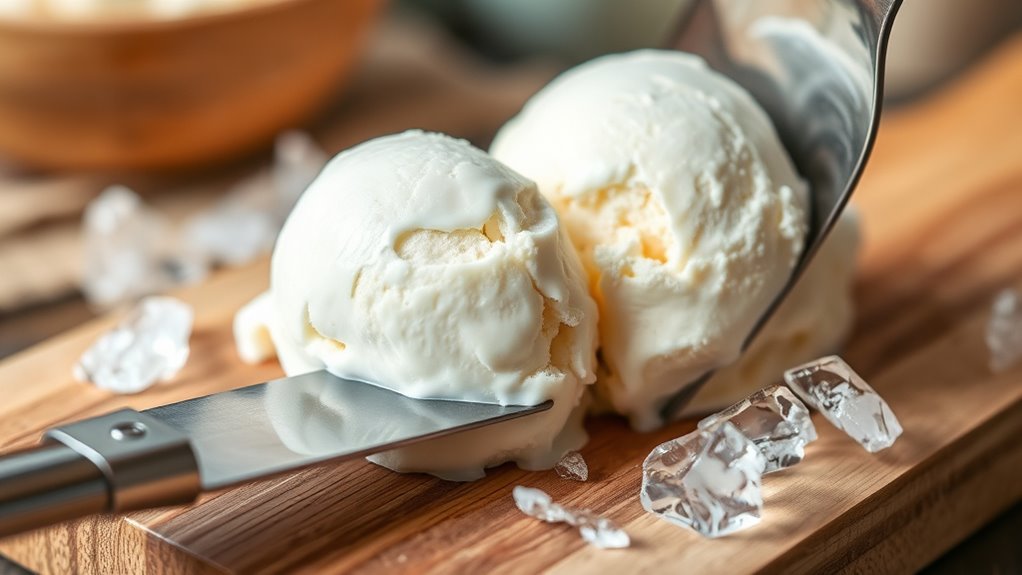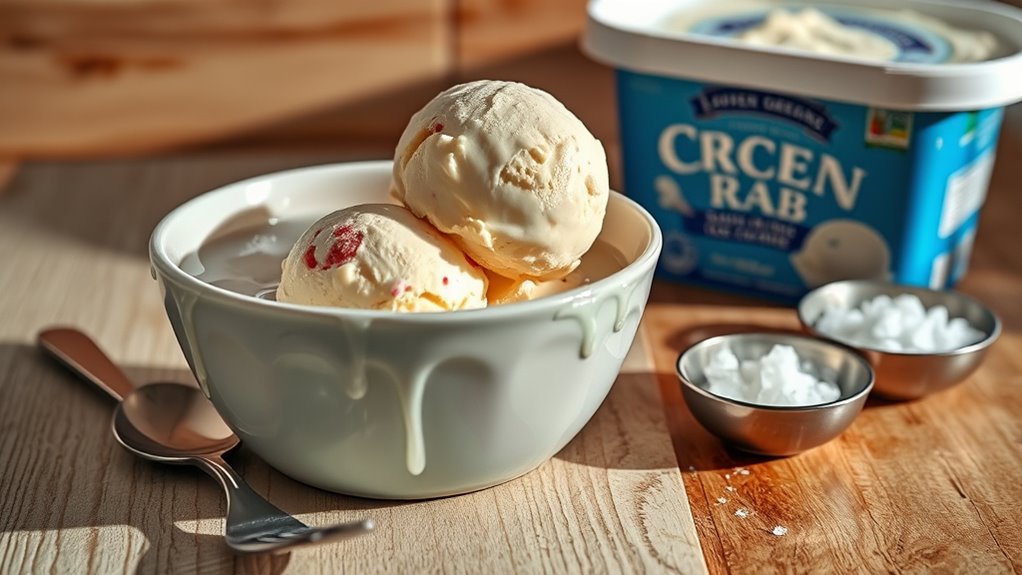If you want to soften ice cream without using a microwave, try a few simple methods. Place the container in the refrigerator for about 30 minutes, or let it sit at room temperature for 10 to 15 minutes. If you need it faster, score it with a hot knife or use a heated scoop. Remember, these techniques will enhance your scooping experience and maintain the quality of your ice cream. There’s more to discover about preserving that creamy goodness!
Key Takeaways
- Leave the ice cream container in the refrigerator for about 30 minutes to achieve the ideal serving temperature.
- Set the container on the countertop for 10 to 15 minutes for a quick softening effect.
- Score the ice cream with a heated knife in a tic-tac-toe pattern for faster softening.
- Dip your scoop in warm water before serving to make scooping easier and smoother.
- Use a specialized ice cream scoop with a warm handle for effortless serving without melting.
Why Thaw Ice Cream?

Why should you consider thawing ice cream before serving?
Thawing ice cream enhances your dessert experience by making it easier to scoop and serve, eliminating that frustrating moment when you struggle with hard ice cream.
Softening ice cream to the ideal temperature allows for better flavor release, making each bite sweeter and more enjoyable.
Softened ice cream enhances flavor release, ensuring each bite is sweeter and more delightful.
Plus, if you’re whipping up ice cream sandwiches or incorporating it into cakes, thawing guarantees that the ice cream mixes smoothly, blending flavors seamlessly.
You’ll avoid the pitfalls of hard centers and melted edges, maintaining a consistent texture throughout. Additionally, average ice cream consumption reveals that many people enjoy ice cream regularly, making a smooth serving experience even more desirable.
How to Soften Ice Cream in the Refrigerator

If you want perfectly softened ice cream without compromising its texture, placing the container in the refrigerator is your best bet. Here’s how to do it effectively:
- Time it Right: Leave the container in the refrigerator for about 30 minutes to reach an ideal temperature of 6 to 10 degrees Fahrenheit.
- Check for Indentation: Gently press with your finger; it should leave a ¼-inch indentation for maximum scoopability.
- Use a Tray: Place the container on a tray or plate to catch any moisture that might accumulate during thawing.
- Plan Ahead: This method is perfect when you have time before serving, ensuring your ice cream maintains its texture.
Enjoy your perfectly softened treat!
How to Soften Ice Cream at Room Temperature

To soften ice cream at room temperature, simply leave the container on the countertop for about 10 to 15 minutes. This method guarantees you achieve a scoopable consistency without excessive melting. Monitor the ice cream closely, especially on hot days, to prevent it from becoming soupy. Setting a kitchen timer can help you keep track of the time.
| Time (Minutes) | Softening Level | Scoopability |
|---|---|---|
| 0 | Hard | Difficult |
| 5 | Slightly Soft | Manageable |
| 10 | Soft | Easy |
| 15 | Very Soft | Perfectly Scoopable |
The outer layer softens while the center remains firmer, making it easier to scoop when the time is right. Enjoy your dessert!
How to Soften Ice Cream by Cutting It

Cutting ice cream is a quick and effective way to soften it for immediate enjoyment. When your ice cream is frozen solid, you can use this method to soften up ice cream quickly.
Follow these steps:
- Heat a sharp knife under hot water to create a hot knife that slices through the ice cream easily.
- Score the ice cream in a tic-tac-toe pattern, both crosswise and lengthwise, to create smaller sections that will soften faster.
- Use a heated ice cream scoop, also warmed under hot water, to dig into the sliced sections for easier scooping.
- Be cautious with hot utensils to avoid burns; make sure the knife isn’t too hot before you start cutting.
Enjoy your perfectly softened treat!
Tips for Easier Scooping

To make scooping ice cream a breeze, try a few simple tricks. Dipping your scoop in warm water or using a specially designed scoop can really help you get the perfect scoop every time.
You can also use a cool bowl technique to prevent the ice cream from sticking, making your dessert experience even more enjoyable.
Warm Water Dipping
Dipping your ice cream scoop in warm water can make a world of difference when it comes to serving hard ice cream. This simple technique helps soften your scoop and allows you to serve with ease.
Here are some tips to get the best results:
- Use warm, not boiling, water to avoid melting the ice cream too quickly and compromising its texture.
- Dip your scoop before each use to create a lubricant effect, making scooping effortless.
- Shake off excess water to prevent your ice cream from becoming soggy.
- Keep a bowl or cup of warm water handy for multiple servings without the need to refill.
With these tips, you’ll enjoy smoother scooping and a better dessert experience!
Use Proper Scoop
When it comes to effortlessly scooping hard ice cream, using the right scoop can make all the difference. A specialized ice cream scoop with a warm handle reduces the effort needed for a smooth scoop, allowing you to enjoy that creamy texture without struggle.
Before each use, dip the scoop in cold water to create a lubricating effect, preventing ice cream from sticking and enabling you to serve neat portions. A scoop with a sharp edge cuts through harder ice cream more effectively, while regularly warming it in hot water between servings keeps it at the right temperature.
For added convenience, opt for an ice cream scoop with a built-in scraper to release the ice cream easily and reduce mess.
Cool Bowl Technique
The cool bowl technique offers a simple yet effective way to soften ice cream quickly. By placing your ice cream in a warm bowl, you allow the heat to gently soften it without losing that creamy consistency.
Here’s how to make the most of this method:
- Choose a bowl that’s warm but not hot to prevent uneven melting.
- Transfer your ice cream into the warm bowl for 5 to 10 minutes.
- Periodically check the texture and stir gently for even softening.
- Once it reaches the desired softness, scoop and enjoy!
This technique helps maintain a delicious texture while avoiding a soupy mess, so you’ll have perfectly softened ice cream ready in no time!
Preventing Ice Crystals

To keep your ice cream creamy, manage airflow effectively.
Seal the container tightly and consider using wax paper on the surface to block air and moisture.
These simple steps can greatly reduce ice crystal formation, ensuring your favorite treat stays smooth and delicious.
Airflow Management Techniques
Excessive airflow in your freezer can wreak havoc on ice cream, causing unwanted ice crystals that ruin its creamy texture.
To manage airflow effectively and keep your ice cream smooth, follow these tips:
- Seal Tight: Always store ice cream in an airtight container to minimize air exposure.
- Limit Freezer Door Openings: Avoid frequently opening the freezer door, as warm air can enter and lead to ice crystal formation.
- Optimal Storage Location: Place your ice cream in the coldest part of the freezer rather than in the door to guarantee a consistent temperature.
- Additional Barrier: Consider covering the surface of the ice cream with wax paper before sealing to create an extra barrier against air.
Additionally, maintaining a consistent temperature in your freezer can help reduce the risks of ice crystal formation, ensuring your ice cream remains creamy and enjoyable.
Wax Paper Usage
While many people overlook it, using wax paper can considerably enhance your ice cream’s texture by preventing ice crystals from forming. By placing wax paper directly on top of your ice cream, you create a barrier that limits air exposure, maintaining its creaminess and preventing that gummy texture. This technique is especially helpful for ice cream stored in open containers, as it reduces moisture loss and preserves flavor. Just remember, when reusing wax paper, verify it’s not stained or torn for maximum effectiveness. Cover your ice cream immediately after use to keep it fresh! Additionally, storing your ice cream in an airtight container can further limit moisture loss and ensure its quality remains intact.
| Benefit | Description | Emotion Evoked |
|---|---|---|
| Prevents Ice Crystals | Keeps ice cream smooth and creamy | Relief |
| Reduces Air Exposure | Minimizes icy texture | Satisfaction |
| Preserves Flavor | Enhances taste | Joy |
| Limits Moisture Loss | Maintains quality | Comfort |
Maintaining Ice Cream Quality

Maintaining ice cream quality is essential if you want to enjoy its rich flavor and creamy texture. Here are four tips to help you keep your ice cream soft enough and delicious:
- Store in the Coldest Part: Keep your ice cream at around -20°F to prevent it from freezing too hard.
- Use Airtight Containers: Minimize air exposure to avoid moisture loss and maintain ice cream quality.
- Cover the Surface: Securely cover your ice cream with wax paper or plastic wrap after each use to limit air exposure and prevent ice crystals from forming.
- Limit Freezer Door Openings: Frequent openings allow warm air in, which can create ice crystals and ruin the texture.
Frequently Asked Questions
How Do You Soften Ice Cream Quickly?
To soften ice cream quickly, try a few handy methods.
First, let it sit at room temperature for about 10 minutes.
If you need it faster, run the container under cold water for about 30 seconds, ensuring it’s sealed.
Another trick is to dip your scoop in hot water before using it; this makes scooping much easier.
Whichever method you choose, you’ll enjoy your ice cream in no time!
How to Turn Hard Ice Cream Into Soft Serve?
To turn hard ice cream into soft serve, let it sit at room temperature for about 10 to 15 minutes. This method softens the outer layer while keeping the center firm.
You can also place the ice cream in the refrigerator for 20 to 30 minutes for a more even texture.
If you’re in a hurry, using a warm bowl or scoring the surface with a hot knife can speed up the softening process.
How Do You Make Ice Cream Softer?
Imagine your ice cream as a frozen fortress, tough to breach. To make it softer, try letting it sit at room temperature for about 10 to 15 minutes.
You could also place it in the refrigerator for 20 to 30 minutes, reaching that perfect scoopable state. Scoring it with a hot knife or using a warm bowl can work wonders too.
Each method helps break down the ice crystals, turning that fortress into a creamy delight!
How to Make Homemade Ice Cream Scoopable?
To make homemade ice cream scoopable, aim for a higher fat content of around 16%.
Incorporating ingredients like xanthan gum can help reduce crystallization, leading to a creamier texture. Use coconut cream or other high-fat alternatives for a smoother consistency.
Churning your mixture in an ice cream maker introduces air, preventing large ice crystals.
Finally, store your ice cream in an airtight container at a slightly warmer temperature, around -10°F, to keep it soft and scoopable.
Conclusion
Now that you know these alternative methods to soften ice cream, you can enjoy your favorite treat without the hassle of microwaving. Whether you let it sit in the fridge, warm it up at room temperature, or simply cut it, you’ll be scooping smoothly in no time. Remember, a little patience goes a long way, so don’t rush the process. With these tips, you’ll be savoring every delicious bite while keeping your ice cream in top shape!









